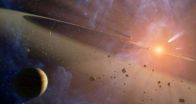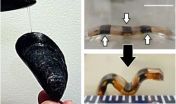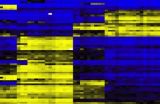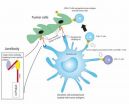(Press-News.org) NASA has successfully concluded a remotely controlled test of new technologies that would empower future space robots to transfer hazardous oxidizer – a type of propellant – into the tanks of satellites in space today.
Concurrently on the ground, NASA is incorporating results from this test and the Robotic Refueling Mission on the International Space Station to prepare for an upcoming ground-based test of a full-sized robotic servicer system that will perform tasks on a mock satellite client.
Collectively, these efforts are part of an ongoing and aggressive technology development campaign to equip robots and humans with the tools and capabilities needed for spacecraft maintenance and repair, the assembly of large space telescopes, and extended human exploration.
Technologies to Help Satellites That Help Earth
The Satellite Servicing Capabilities Office (SSCO) at NASA's Goddard Space Flight Center in Greenbelt, Md., checked another critical milestone off their list with the completion of their Remote Robotic Oxidizer Transfer Test (RROxiTT) in February 2014.
"This is the first time that anyone has tested this type of technology, and we've proven that it works. It's ready for the next step to flight," says Frank Cepollina, veteran leader of the five servicing missions to the Hubble Space Telescope and the associate director of SSCO.
"RROxiTT gives NASA, and the satellite community at large, confidence that advanced satellite refueling and maintenance technologies aren't a wild dream of the future," says Cepollina. "They're being built and tested today – and the capabilities that they can unlock can become a reality."
Since 2009, SSCO has been investigating human and robotic satellite servicing while developing the technologies necessary to bring on-orbit spacecraft inspection, repair, refueling, component replacement and assembly capabilities to space.
Taking lessons learned from the successful Robotic Refueling Mission, the SSCO team devised the ground-based RROxiTT to test how robots can transfer hazardous oxidizer, at flight-like pressures and flow rates, through the propellant valve and into the mock tank of a satellite.
While this capability could be applied to spacecraft in multiple orbits, SSCO focused RROxiTT specifically on technologies that could help satellites traveling the busy space highway of geosynchronous Earth orbit, or GEO.
Located about 22,000 miles above Earth, this orbital path is home to more than 400 satellites, many of which beam communications, television and weather data to customers worldwide.
By developing robotic capabilities to repair and refuel GEO satellites, NASA hopes to add precious years of functional life to satellites and expand options for operators who face unexpected emergencies, tougher economic demands and aging fleets. NASA also hopes that these new technologies will help boost the commercial satellite-servicing industry that is rapidly gaining momentum.
Besides aiding the GEO satellite community, a capability to fix and relocate "ailing" satellites also could help mitigate the growing orbital debris problem that threatens continued space operations, ultimately making space greener and more sustainable.
Goddard and Kennedy Collaborate on New Technologies
RROxiTT tested a suite of new robotic technologies and procedures developed by the SSCO team at two collaborating centers, Goddard and Kennedy Space Center, Fla.
Technologies included a flexible propellant hose, a new Oxidizer Nozzle Tool, and a unique propellant transfer system (PTS) all developed by the multi-Center SSCO team. The PTS, consisting of oxidizer tanks, seal-less pumps, flow-metering devices, and a maze of tubing, contains the components a servicer satellite would need to replenish the propellant of orbiting spacecraft for many years of extended life.
During operations, a robot operator at NASA Goddard in Maryland commanded an industrial robot at Kennedy in Florida -- more than 800 miles away -- to mate to a satellite valve and transfer propellant into a mock tank. At the conclusion of nine days of RROxiTT operations, the SSCO team declared victory.
"It's one thing to build a set of technologies and discover that they work," says Benjamin Reed, deputy project manager of SSCO at Goddard. "It's another thing to consider the capabilities that they could unlock. The paradigm of one-and-done should be relegated to the 20th century – the future of space will be re-use, re-purpose and replenish."
Applications to Help People Stay Safer on Earth
While RROxiTT technologies are being designed for use in space, they may one day be applied to robotically replenish satellites before they launch.
Oxidizer – namely nitrogen tetroxide – is a chemical that, when mixed with satellite fuel, causes instant combustion that provides thrust (motion) for a satellite. The liquid is contained within a satellite tank at intense pressures, up to 300 pounds per square inch (about 20 times atmospheric pressure). Toxic, extremely corrosive and compressed, it requires special handling.
Using these new RROxiTT technologies to robotically fill up satellites on the ground would keep humans at a safe distance during these extremely hazardous operations.
Future Satellite Servicing Demonstrations
Since wrapping up RROxiTT, SSCO is broadening its portfolio to include xenon transfer technologies -- propellant used by satellites with electric propulsion systems.
The team is also gearing up for the next phase of the Robotic Refueling Mission on the International Space Station. The next Automated Transfer Vehicle, currently scheduled to launch to the space station in June of this year, will deliver new RRM hardware for a fresh set of activities.
Upcoming demonstrations include spacecraft inspection, the replenishment of cryogens in satellites not originally designed for in-flight service, and advanced solar cell technology. A separate space station demonstration currently in development will focus on real-time relative navigation.
On the ground, SSCO will be conducting a separate test at Goddard in later this year. Drawing from lessons learned from RRM, RROxiTT, and their efforts in robot algorithms and development, the team will command a full-sized robot servicer system to perform a series of servicing tasks on a suspended satellite mockup. Results will help the team evaluate how the numerous servicer subsystems and technologies work together as an integrated system to accomplish servicing objectives. The event will test both proven and newly developed technologies.
"Sustainable space development is not only good stewardship of the shared resource of outer space," says Reed, "but it also makes sense as we develop the skill set to embark humans deeper into our solar system."
INFORMATION:
Dewayne Washington and Adrienne Alessandro
NASA's Goddard Space Flight Center, Greenbelt, Md.
NASA tests new robotic refueling technologies
2014-03-05
ELSE PRESS RELEASES FROM THIS DATE:
OU study suggests non-uniform climate warming global
2014-03-05
A recent University of Oklahoma study of five decades of satellite data, model simulations and in situ observations suggests the impact of seasonal diurnal or daily warming varies between global regions affecting many ecosystem functions and services, such as food production, carbon sequestration and climate regulation. The effects of non-uniform climate warming on terrestrial ecosystems is a key challenge in carbon cycle research and for those making future predictions.
Jianyang Xia, a research associate in the OU College of Arts and Sciences, says the impact of non-uniform ...
A small step toward discovering habitable earths
2014-03-05
University of Arizona researchers snapped images of a planet outside our solar system with an Earth-based telescope using essentially the same type of imaging sensor found in digital cameras instead of an infrared detector. Although the technology still has a very long way to go, the accomplishment takes astronomers a small step closer to what will be needed to image earth-like planets around other stars
"This is an important next step in the search for exoplanets because imaging in visible light instead of infrared is what we likely have to do if we want to detect planets ...
Researchers find potential target for drug to treat allergic asthma
2014-03-05
COLUMBUS, Ohio – An enzyme that helps maintain immune system function by "throwing away" a specific protein has a vital role in controlling symptoms of allergic asthma, new research in mice suggests.
The finding suggests that this enzyme, called Cbl-b, could be a target for drugs used to treat allergic asthma and other autoimmune disorders.
This new study, led by Ohio State University researchers, is the first to link Cbl-b to allergic asthma in an animal model.
The findings parallel results from a 2012 Yale study in humans, which suggested that a mutation in the ...
Pumping iron: A hydrogel actuator with mussel tone
2014-03-05
Protein from a small, tasty mollusk inspired Michigan Technological University's Bruce P. Lee to invent a new type of hydrogel actuator.
Hydrogels are soft networks of polymers with high water content, like jello. Because of their soft, gentle texture, they have the potential to interact safely with living tissues and have applications in a number of medical areas, including tissue engineering. Lee, an assistant professor of biomedical engineering, wanted to make a hydrogel that wouldn't just sit there.
"Hydrogels that can change shape on command could be used to deliver ...
Going viral to target tumors
2014-03-05
March 5, 2014, New York, NY– A Ludwig Cancer Research study suggests that the clinical efficacy of checkpoint blockade, a powerful new strategy to harness the immune response to treat cancers, might be dramatically improved if combined with oncolytic virotherapy, an investigational intervention that employs viruses to destroy tumors.
Published today in the journal Science Translational Medicine, the study evaluated a combination therapy in which the Newcastle disease virus (NDV), a bird virus not ordinarily harmful to humans, is injected directly into one of two melanoma ...
Biomarkers of cell death in Alzheimer's reverse course after symptom onset
2014-03-05
Three promising biomarkers being studied to detect Alzheimer's disease in its early stages appear to undergo a surprising shift as patients develop symptoms of dementia, researchers at Washington University School of Medicine in St. Louis report.
Scientists use the biomarkers to assess brain changes linked to the disease in research volunteers. The levels of markers of neuronal injury increase in the spinal fluid for a decade or more before the onset of dementia, but in a new twist, the research shows for the first time that they later reverse course, decreasing as symptoms ...
An inventive new way to profile immune cells in blood
2014-03-05
ROVIDENCE, R.I. [Brown University] — When a person becomes sick or is exposed to an unwelcome substance, the body mobilizes specific proportions of different immune cells in the blood. Methods of discovering and detecting those profiles are therefore useful both clinically and in research. In a new paper in the journal Genome Biology, a team of scientists describes a new and uniquely advantageous way to detect them.
All the current means of counting immune cells in a blood sample require whole cells, said Karl Kelsey, professor of epidemiology at Brown and corresponding ...
Novel cancer vaccine holds promise against ovarian cancer, mesothelioma
2014-03-05
A novel approach to cancer immunotherapy – strategies designed to induce the immune system to attack cancer cells – may provide a new and cost-effective weapon against some of the most deadly tumors, including ovarian cancer and mesothelioma. Investigators from the Massachusetts General Hospital (MGH) Vaccine and Immunotherapy Center report in the Journal of Hematology & Oncology that a protein engineered to combine a molecule targeting a tumor-cell-surface antigen with another protein that stimulates several immune functions prolonged survival in animal models of both ...
Hungry for 'likes': Frequent Facebook use linked to eating disorder risk, study finds
2014-03-05
TALLAHASSEE, Fla. — Frequent Facebook users might be sharing more than party pictures, vacation videos and shameless selfies — they also share a greater risk of eating disorders, according to a new study led by Florida State University researchers.
Psychology Professor Pamela K. Keel studied 960 college women and found that more time on Facebook was associated with higher levels of disordered eating. Women who placed greater importance on receiving comments and "likes" on their status updates and were more likely to untag photos of themselves and compare their own photos ...
Prenatal nicotine exposure may lead to ADHD in future generations
2014-03-05
TALLAHASSEE, Fla. — Prenatal exposure to nicotine could manifest as attention deficit hyperactivity disorder in children born a generation later, according to a new study by Florida State University College of Medicine researchers.
Professors Pradeep G. Bhide and Jinmin Zhu have found evidence that ADHD associated with nicotine can be passed across generations. In other words, your child's ADHD might be an environmentally induced health condition inherited from your grandmother, who may have smoked cigarettes during pregnancy a long time ago. And the fact that you never ...






